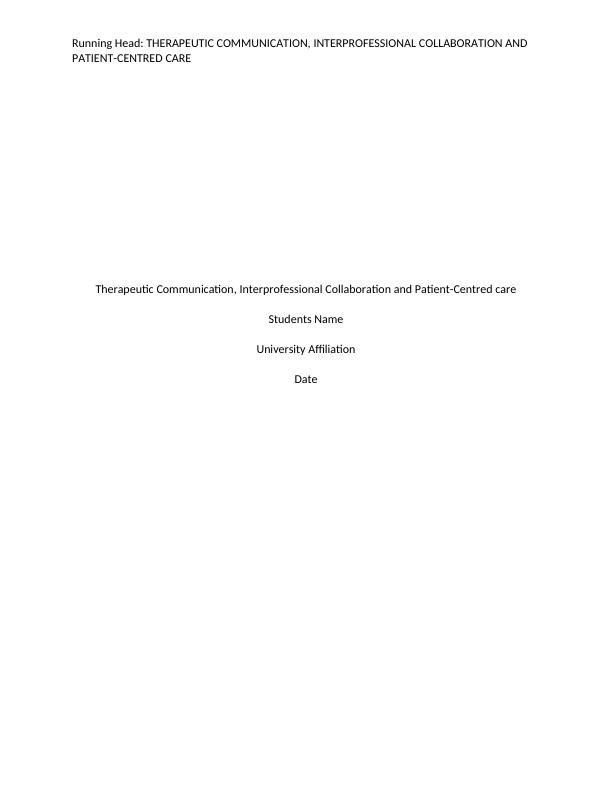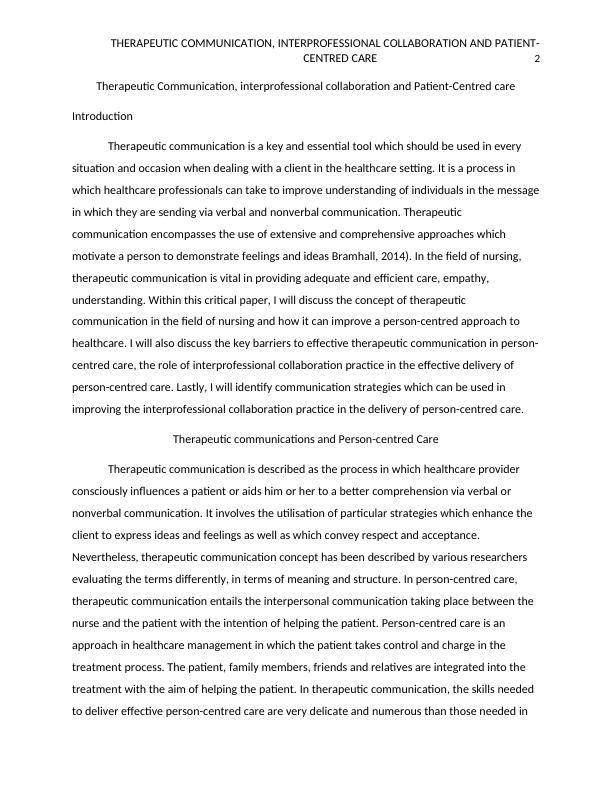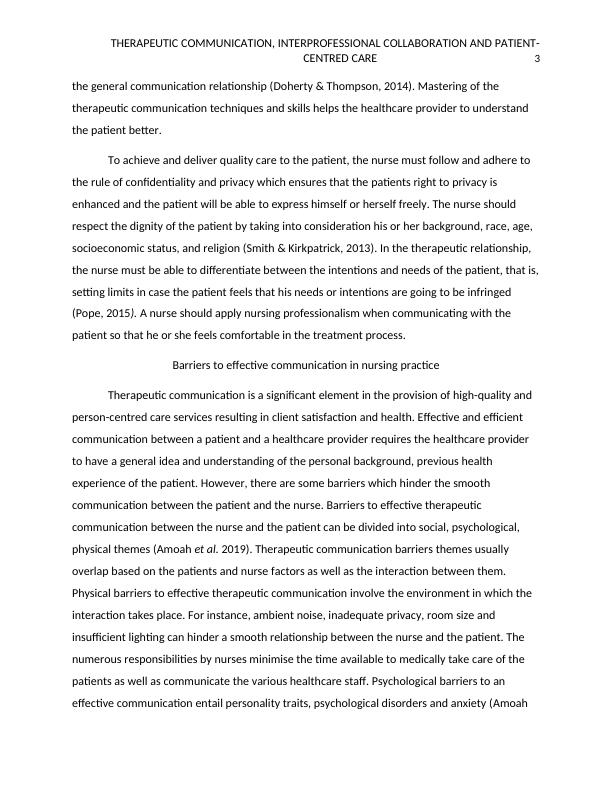Therapeutic Communication, Interprofessional Collaboration and Patient-Centred Care
Added on 2023-04-11
7 Pages1373 Words325 Views
Running Head: THERAPEUTIC COMMUNICATION, INTERPROFESSIONAL COLLABORATION AND
PATIENT-CENTRED CARE
Therapeutic Communication, Interprofessional Collaboration and Patient-Centred care
Students Name
University Affiliation
Date
PATIENT-CENTRED CARE
Therapeutic Communication, Interprofessional Collaboration and Patient-Centred care
Students Name
University Affiliation
Date

THERAPEUTIC COMMUNICATION, INTERPROFESSIONAL COLLABORATION AND PATIENT-
CENTRED CARE 2
Therapeutic Communication, interprofessional collaboration and Patient-Centred care
Introduction
Therapeutic communication is a key and essential tool which should be used in every
situation and occasion when dealing with a client in the healthcare setting. It is a process in
which healthcare professionals can take to improve understanding of individuals in the message
in which they are sending via verbal and nonverbal communication. Therapeutic
communication encompasses the use of extensive and comprehensive approaches which
motivate a person to demonstrate feelings and ideas Bramhall, 2014). In the field of nursing,
therapeutic communication is vital in providing adequate and efficient care, empathy,
understanding. Within this critical paper, I will discuss the concept of therapeutic
communication in the field of nursing and how it can improve a person-centred approach to
healthcare. I will also discuss the key barriers to effective therapeutic communication in person-
centred care, the role of interprofessional collaboration practice in the effective delivery of
person-centred care. Lastly, I will identify communication strategies which can be used in
improving the interprofessional collaboration practice in the delivery of person-centred care.
Therapeutic communications and Person-centred Care
Therapeutic communication is described as the process in which healthcare provider
consciously influences a patient or aids him or her to a better comprehension via verbal or
nonverbal communication. It involves the utilisation of particular strategies which enhance the
client to express ideas and feelings as well as which convey respect and acceptance.
Nevertheless, therapeutic communication concept has been described by various researchers
evaluating the terms differently, in terms of meaning and structure. In person-centred care,
therapeutic communication entails the interpersonal communication taking place between the
nurse and the patient with the intention of helping the patient. Person-centred care is an
approach in healthcare management in which the patient takes control and charge in the
treatment process. The patient, family members, friends and relatives are integrated into the
treatment with the aim of helping the patient. In therapeutic communication, the skills needed
to deliver effective person-centred care are very delicate and numerous than those needed in
CENTRED CARE 2
Therapeutic Communication, interprofessional collaboration and Patient-Centred care
Introduction
Therapeutic communication is a key and essential tool which should be used in every
situation and occasion when dealing with a client in the healthcare setting. It is a process in
which healthcare professionals can take to improve understanding of individuals in the message
in which they are sending via verbal and nonverbal communication. Therapeutic
communication encompasses the use of extensive and comprehensive approaches which
motivate a person to demonstrate feelings and ideas Bramhall, 2014). In the field of nursing,
therapeutic communication is vital in providing adequate and efficient care, empathy,
understanding. Within this critical paper, I will discuss the concept of therapeutic
communication in the field of nursing and how it can improve a person-centred approach to
healthcare. I will also discuss the key barriers to effective therapeutic communication in person-
centred care, the role of interprofessional collaboration practice in the effective delivery of
person-centred care. Lastly, I will identify communication strategies which can be used in
improving the interprofessional collaboration practice in the delivery of person-centred care.
Therapeutic communications and Person-centred Care
Therapeutic communication is described as the process in which healthcare provider
consciously influences a patient or aids him or her to a better comprehension via verbal or
nonverbal communication. It involves the utilisation of particular strategies which enhance the
client to express ideas and feelings as well as which convey respect and acceptance.
Nevertheless, therapeutic communication concept has been described by various researchers
evaluating the terms differently, in terms of meaning and structure. In person-centred care,
therapeutic communication entails the interpersonal communication taking place between the
nurse and the patient with the intention of helping the patient. Person-centred care is an
approach in healthcare management in which the patient takes control and charge in the
treatment process. The patient, family members, friends and relatives are integrated into the
treatment with the aim of helping the patient. In therapeutic communication, the skills needed
to deliver effective person-centred care are very delicate and numerous than those needed in

THERAPEUTIC COMMUNICATION, INTERPROFESSIONAL COLLABORATION AND PATIENT-
CENTRED CARE 3
the general communication relationship (Doherty & Thompson, 2014). Mastering of the
therapeutic communication techniques and skills helps the healthcare provider to understand
the patient better.
To achieve and deliver quality care to the patient, the nurse must follow and adhere to
the rule of confidentiality and privacy which ensures that the patients right to privacy is
enhanced and the patient will be able to express himself or herself freely. The nurse should
respect the dignity of the patient by taking into consideration his or her background, race, age,
socioeconomic status, and religion (Smith & Kirkpatrick, 2013). In the therapeutic relationship,
the nurse must be able to differentiate between the intentions and needs of the patient, that is,
setting limits in case the patient feels that his needs or intentions are going to be infringed
(Pope, 2015). A nurse should apply nursing professionalism when communicating with the
patient so that he or she feels comfortable in the treatment process.
Barriers to effective communication in nursing practice
Therapeutic communication is a significant element in the provision of high-quality and
person-centred care services resulting in client satisfaction and health. Effective and efficient
communication between a patient and a healthcare provider requires the healthcare provider
to have a general idea and understanding of the personal background, previous health
experience of the patient. However, there are some barriers which hinder the smooth
communication between the patient and the nurse. Barriers to effective therapeutic
communication between the nurse and the patient can be divided into social, psychological,
physical themes (Amoah et al. 2019). Therapeutic communication barriers themes usually
overlap based on the patients and nurse factors as well as the interaction between them.
Physical barriers to effective therapeutic communication involve the environment in which the
interaction takes place. For instance, ambient noise, inadequate privacy, room size and
insufficient lighting can hinder a smooth relationship between the nurse and the patient. The
numerous responsibilities by nurses minimise the time available to medically take care of the
patients as well as communicate the various healthcare staff. Psychological barriers to an
effective communication entail personality traits, psychological disorders and anxiety (Amoah
CENTRED CARE 3
the general communication relationship (Doherty & Thompson, 2014). Mastering of the
therapeutic communication techniques and skills helps the healthcare provider to understand
the patient better.
To achieve and deliver quality care to the patient, the nurse must follow and adhere to
the rule of confidentiality and privacy which ensures that the patients right to privacy is
enhanced and the patient will be able to express himself or herself freely. The nurse should
respect the dignity of the patient by taking into consideration his or her background, race, age,
socioeconomic status, and religion (Smith & Kirkpatrick, 2013). In the therapeutic relationship,
the nurse must be able to differentiate between the intentions and needs of the patient, that is,
setting limits in case the patient feels that his needs or intentions are going to be infringed
(Pope, 2015). A nurse should apply nursing professionalism when communicating with the
patient so that he or she feels comfortable in the treatment process.
Barriers to effective communication in nursing practice
Therapeutic communication is a significant element in the provision of high-quality and
person-centred care services resulting in client satisfaction and health. Effective and efficient
communication between a patient and a healthcare provider requires the healthcare provider
to have a general idea and understanding of the personal background, previous health
experience of the patient. However, there are some barriers which hinder the smooth
communication between the patient and the nurse. Barriers to effective therapeutic
communication between the nurse and the patient can be divided into social, psychological,
physical themes (Amoah et al. 2019). Therapeutic communication barriers themes usually
overlap based on the patients and nurse factors as well as the interaction between them.
Physical barriers to effective therapeutic communication involve the environment in which the
interaction takes place. For instance, ambient noise, inadequate privacy, room size and
insufficient lighting can hinder a smooth relationship between the nurse and the patient. The
numerous responsibilities by nurses minimise the time available to medically take care of the
patients as well as communicate the various healthcare staff. Psychological barriers to an
effective communication entail personality traits, psychological disorders and anxiety (Amoah

End of preview
Want to access all the pages? Upload your documents or become a member.
Related Documents
Therapeutic Communication Skills and Inter-Professional Collaboration in Nursinglg...
|8
|1847
|470
Ethical Therapeutic Relationship Developmentlg...
|1
|559
|42
Therapeutic Communication: Skills, Barriers, and Interprofessional Collaboration for Patient-Centered Carelg...
|9
|2754
|88
Health Assessment Interview Assignmentlg...
|6
|1316
|34
Importance of Therapeutic Communication in Healthcarelg...
|8
|1546
|311
The nursing communication for therapeuticlg...
|8
|1794
|24